Life
Sign up for our newsletter
We summarize the week's scientific breakthroughs every Thursday.
-
 Neuroscience
NeuroscienceMagnets in helmets might make football safer
The repulsive force of magnets in football helmets could slow the impact of collisions, reducing concussion danger and making the game safer.
-
 Environment
EnvironmentColorado deluge produced flood of drug-resistance genes
Flooding in Colorado’s South Platte River Basin washed antibiotics and drug-resistance genes into pristine waterways.
By Beth Mole -
 Archaeology
ArchaeologyFeedback
Readers ask questions about a study on sweeteners, how scientists recognize primitive tools and the purpose of a dinosaur's sail.
-
 Environment
EnvironmentSpiders enlisted as pollution sensors for rivers
Hunting arachnids provide a better picture of chemical threats to food web.
By Beth Mole -
 Animals
AnimalsAnt colonies prefer homes infected with fungus
Choosing a new nest site ridden with a potentially deadly fungus may be a way for pharaoh ants to immunize themselves against the pathogen, scientists say.
-
 Life
LifeSemen seems to counteract microbicides that kill HIV
Semen seems to inhibit most microbicides from killing HIV, but one that targets a receptor on cells remains effective, suggesting a promising approach against HIV.
-
 Life
LifeStudy finds lack of evidence for infanticide link to monogamy
A new study contradicts idea that the rise of infanticide among mammals drove the evolution of monogamy.
By Susan Milius -
 Animals
AnimalsGiant otters hum, scream, say ‘hah’ and more
Often overlooked as vocalists, giant otters make 22 different calls as adults and 11 kinds of baby babble.
-
 Neuroscience
NeuroscienceStopped brain clock saves memory in hamsters
Broken timekeeper in brain may explain some memory problems, hamster study suggests.
By Meghan Rosen -
 Animals
AnimalsFew humans were needed to wipe out New Zealand’s moa
A new study finds that the Maori population was still small when it managed to drive several species of large, flightless birds extinct.
-
 Genetics
GeneticsRare mutations may protect against heart disease
Rare mutations in a key gene seem to lower bad cholesterol and provide protection against heart disease.
By Nathan Seppa -
 Health & Medicine
Health & MedicineFoul smells during sleep may help smokers quit
A night of smelling rotten eggs and fish while inhaling cigarette odors makes smokers reach for fewer cigarettes upon waking.